
Airsoft Innovations Tornado Airsoft Grenade
4th June 2008 - If you've read this review before this date, read it again as I've carried out further testing.
Carl at Airsoft Innovations has been good enough to send me various gas related items for review in the past, including their well known Propane and Duster Gas adaptors, but when he said he was sending me one of their new items to review, I wasn't entirely sure what to expect.

The latest product from the Canadian firm is the Tornado Airsoft Grenade, which uses 134a/Duster or Green/Propane gas to propel up to 180BBs in a 360 degree direction from the grenade.
Unlike some other Airsoft Grenades, it doesn't use any pyrotechnics, working more like a gas gun and there are many clever design features built into it, but would it actually work as intended?
In the Box
I was quite surprised by the box.
In the past items from AI have come in plastic bags, but the Tornado (and the gas kit I received with it) was packed in a professional looking cardboard box with AI branding. The packaging is simple and looks commendably recyclable, although I'm not sure about the plastic bag the Tornado was sealed in inside the box.
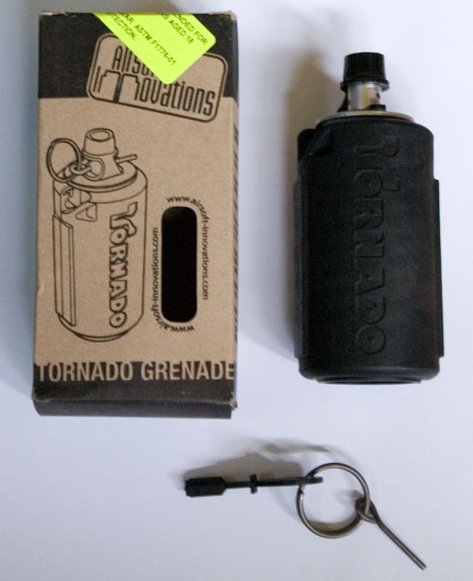
In the box is the Tornado and a short instruction manual.
First Impressions
Anyone looking for a replica hand grenade to make them look mil-sim will probably be a little disappointed that the Tornado makes little effort to look like a real grenade.
The black plastic housing is smoothly finished and cylindrical and has the word TORNADO cast into it on one side and lots of safety information on the other.
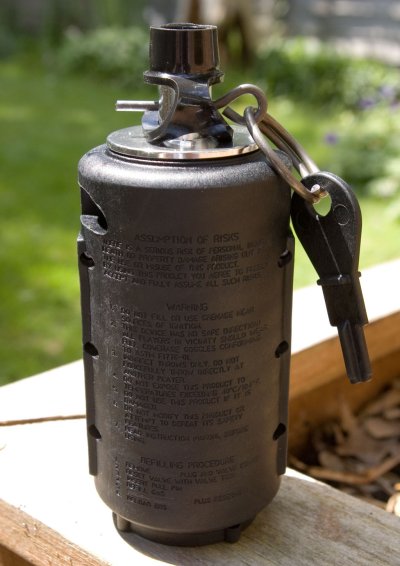
The housing is actually two parts fixed together with six Torx bolts
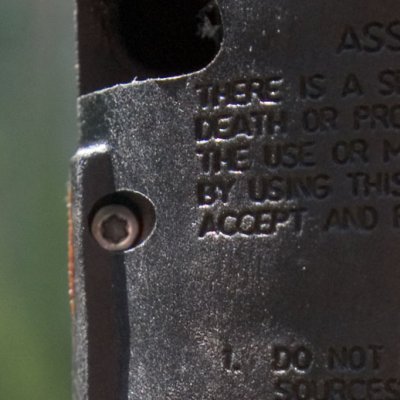
Whilst there is a pin, there is no safety handle (or Spoon - more on that in a minute), as AI say this would simply get lost and the aim is to produce a functional airsoft hand grenade, rather than a cosmetic one, many of which already exist, some serving as BB or gas holders.
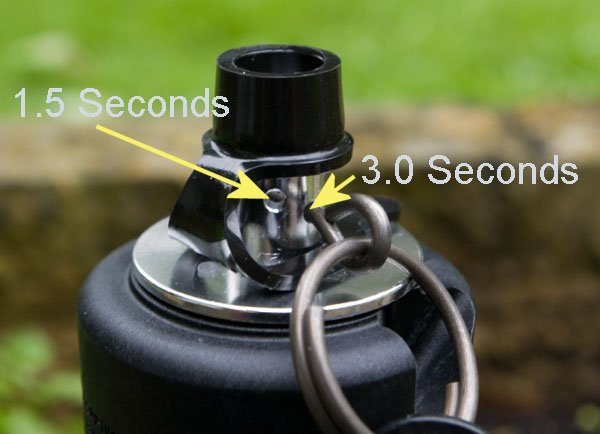
inside the Tornado is a brightly polished metal cylinder topped with a fuse assembly of sorts.
Two holes are drilled part way up the 'fuse' into which the pin fits and there is another in the upper face of the metal part of the body (see picture).
The Tornado is around 13 CM high, 5.5 CM in diameter and weighs around 210g (7.4 ounces).
It feels solid and looks extremely well made.
Closer Look
Loading the Tornado is explained in the instruction booklet (Also available online, here) and seems a little complicated at first sight, although I found it simple second time around, so is obviously not that difficult to grasp. Regular users will soon find it a natural process.
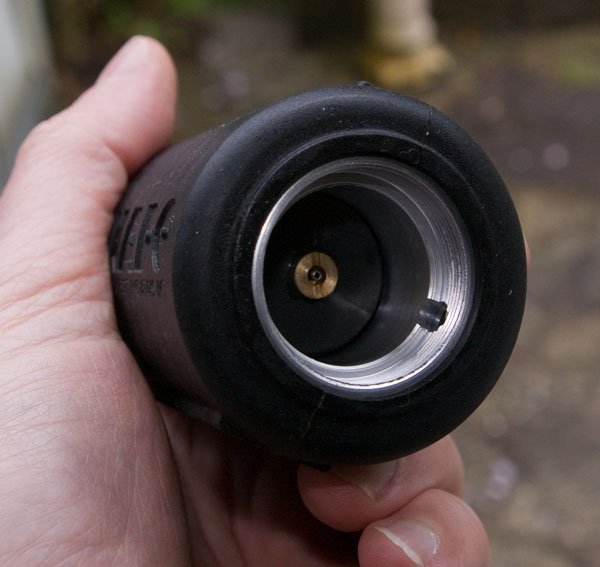
First, you unscrew the base cap (This serves as a fail safe safety - Without this fitted, the grenade cannot fire).
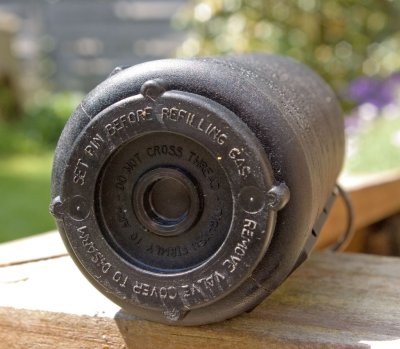
Then remove the rubber plug from the timer plug hole on the top face of the grenade.
Push the provided valve key down the fuse 'nozzle', this will push the whole grenade mechanism down inside the body and allow the pin to be inserted. If you put the pin in the top holes on the 'fuse' you will get a short (stated as 1.5 second delay) for airbursts, whilst the lower holes deliver a longer (3 second stated) delay.
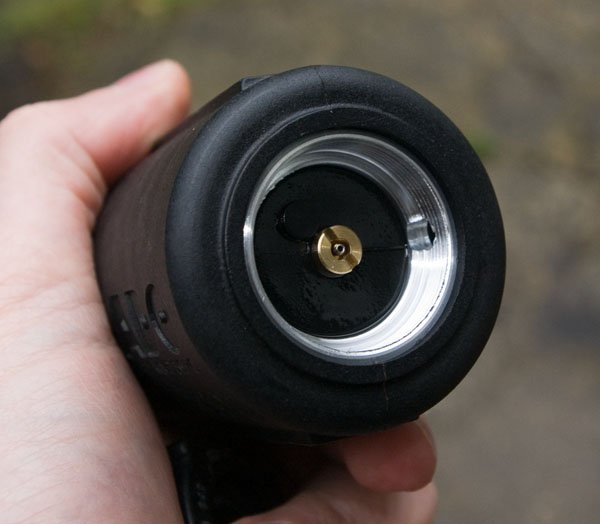
You then gas the grenade using any normal gas canister (including, of course, Propane or Duster using the AI adaptors), via a normal looking gas fill valve visible in the base of the grenade, with the end cap off.
Next (vital!) step is to replace the timer plug in the hole on the top of the grenade. Be ultra aware of replacing this, though, as if you don't the grenade will activate the instant you remove the pin!
Loading BBs is done by using a speed loader (loading 180 BBs by hand would be a chore anyway, but it's not really possible) to load BBs into two loading holes near the top of the plastic shell. These are actually entrances to two sprial tubes which are angled differently (one upwards at 45 degrees and one downwards at 35) to provide a 3D spread of BBs once the grenade is 'detonated' and one of the key elements in the Tornado's design.
One seemed easy to fill using my pistol mag speed loader, but the other was more difficult to align the nozzle to, resulting in BBs sometimes spilling out.
At this stage the Tornado is fundamentally safe and can be carried around with no fear of it going off.
To arm the Tornado, you will need to screw the base cap back on. At this point the grenade is armed - If you don't use your Tornado in a game, you can simply remove the cap to render it safe again.
You are now ready to use the Tornado.
Pulling the pin will activate the grenade and once you have, you need to use it as replacing the pin will not render it safe. Fortunately, the pin requires a good hard pull (someone has tested it around 5-7 lbs), so is not likely to ever fall out.
In terms of time to toss the Tornado, I found that the 3 second delay was actually around 4.5-5 seconds on a warm UK May afternoon (around 22C), although Airsoft Innovations indicate that this varies with ambient temperature and gas type, so if you live in climes where 30C is more common, they advise that you should stick to Duster gas, as occassionally they have seen instant detonations with Propane at high temperatures.
As you can see and hear below, the Tornado goes off with a mild crack, not unlike the sound from a powerful GBB (It expends all its gas in one shot, unlike a GBB, but you are getting up to 180 shots from one fill!).
In my first test I had loaded around 80 BBs, but I was only able to find around 8 of them in my garden.
The good news is that they were scattered in varying directions from the Tornado and the furthest I found was an impressive 10m away from the grenade.
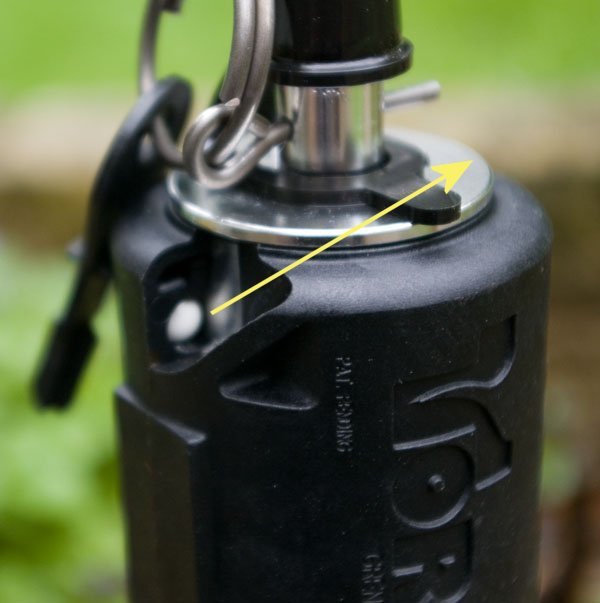
In an earlier test, a BB from the grenade actually hit me from about 3m away. It was certainly a hard enough hit to feel through jeans at that range, causing a sting which remained for 5 minutes or so, but no mark on the skin.
Airsoft Innovations report velocity (with Propane) as being between 65 fps and 160fps (first to last BB. This has the effect of throwing some BBs further than others, increasing the spread) and have carried out tests (themselves) lying on the BB without anything that would be considered more serious than being hit with an AEG and from my experience, it certainly felt no worse than catching a ricochet from a typical GBB.
As the Tornado expels all its gas in one 'shot', it also uses lubrication very quickly. To this end, AI recommend two drops of their provided Grenade oil (heavy weight silicon lube) every two uses of the Tornado.
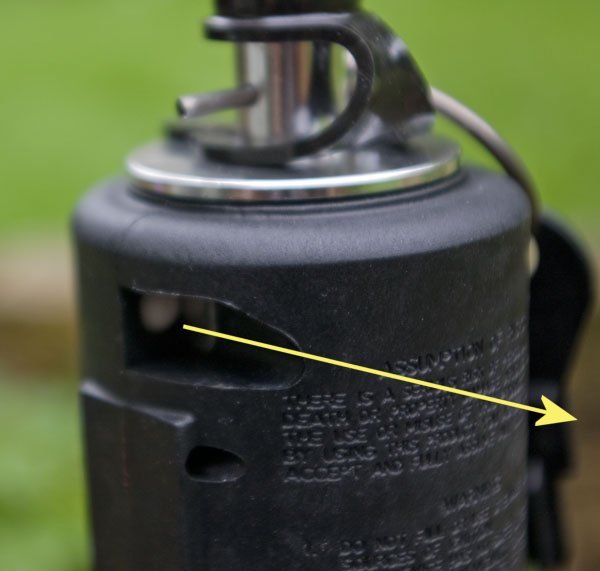
The only concern I'd have about this is obtaining supplies of the correct weight lubricant in countries outside North America, as buying an odd bottle of the oil every few months from Canada would be prohibitively expensive in terms of postage.
The grenade's shell stood up well to falling onto my patio (and the metal drain cover audible in the video above) with no signs of scratching over my testing, but only regular skirmish usage over months will reveal the true strength of the Tornado.
The Tornado is packed with safety features. As well as being inert with the base plate removed, there is an overpressure valve built into the shell (see image of fired Grenade) which prevents the grenade going off in a hot car.
There is also a blow off rubber valve in the base plate, which will pop out in the event that the pressure relief valve is jammed in some way (So don't try filling Tornados with CO2!).
I needed to assess the spread more effectively than my garden testing had allowed, so I decided to place the grenade inside a 'wall' of paper to determine the claim of a 360 degree BB spread.
I ended up building a JustPistols Pat. Pending Grenade Testing device.
As you can see, it's a box which contained Stella Artois bottles with all the sides cut out and 80GSM photocopier paper selotaped (That's Scotch Taped to those of you over the Pond) over the openings.
On a cool, rainy day (about 15C out), I initially tried using Duster Gas, but the grenade refused to go off. Airsoft Innovations recommend Duster over 25C, so perhaps I was being unrealistic.
I regassed with Propane and stood the Tornado up inside the grenade tester and it fired fine.
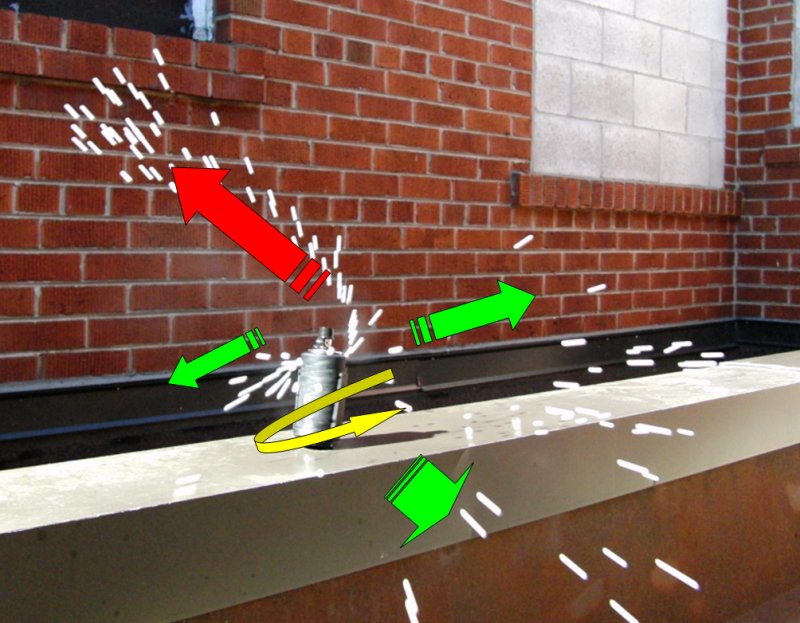
Still from the AI video below, showing the direction of spin - As you can see the BBs closest to the camera are going in a different direction to the latest, as the Grenade spins
I was a little surprised to see that few BBs pierced the paper, but the few that escaped through the top of the box or out of the sides of the paper found their way up to 15 feet away.
With the Tornado starting upright there were hits in all 4 sides of the box and a few BBs escaped though the opening at the top of the box. All the areas outlined in red in the photos above showed BB hits.

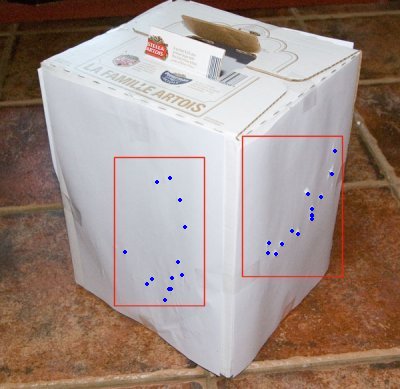
You can see how some hits are higher than others, producing a dome of BBs when 'detonated' in this position.
I regassed and reloaded the Tornado and lay it down in the tester, with new sheets of paper taped to the openings.
This time the spread was different. A lot more BBs exited the top of the box (through the small opening I left to drop the grenade in through) and two sides were clearly hit by a good number of BBs (below).

On the other side, though, one side showed no BB hits and the other side only a few light hits.
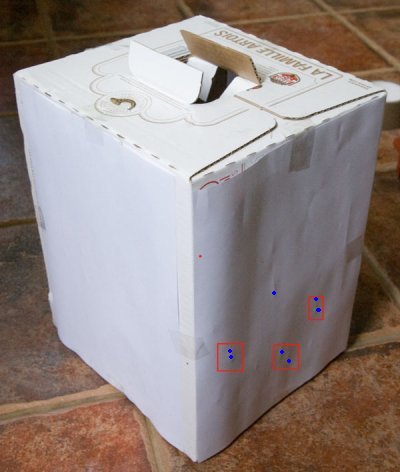
The box probably constrained the grenade propensity to roll around and spray BBs in different directions, but this is no more restrictive, I suspect, than mud or loose sand.
Another AI video showing the Tornado 'firing' in slow motion
Update : June 4th 2008 Some days after my first testing, on a warm (around 22C) day, I was able to carry out another test.
This time, I simply tossed the grenade onto a soft material on grass and videoed the results.
Test firing of a Tornado Grenade - Even on a soft surface, spread is impresive
As you can see, the spread is wide ranging, even firing from its side on a softish surface.
The BBs went in all directions; some almost directly upwards, clearing an 8ft fence behind the grenade and some BBs were as far as 8-10m away from the point of 'detonation'.
Mud or sand would undoubtedly restrict the grenade's movement, but I was impressed with the effect after my box test, which appears to have constrained the Tornado more than I imagined.
Conclusions
Overall, the Tornado seems a very effective airsoft tool.
It should work especially well in CQB situations or when clearing bunkers or trenches.
Some will wish it looked more like a genuine grenade and some, no doubt, will consider $100 a higher price than they wish to pay (I'm sure many will think twice about throwing it into dense undergrowth for fear of not finding it again), but it genuinely seems a fair price to me, such is the quality and ingenuity of the design.
For the unique ability to take on opponents behind cover, the price (less than even the cheapest GBBs) seems perfectly reasonable.
Airsoft Innovations promotional video
AI are to be applauded for bringing something genuinely new to the airsoft market and the Tornado seems to deliver on all their promises.
There are other gas powered BB grenades out there, notably from Deepfire and Escort, but (although I have not seen them first hand) reports suggest they offer very limited range and/or low BB capacity.
In a variey conditions, the Tornado seems to offer a great spread of BBs, although this appears to reduce if the Grenade cannot move around (as may be the case if it landed in loose sand or mud).
The need for bespoke lubricant is a bit of a concern, too, although in my testing I've hardly started to make inroads into the original bottle (AI estimate one bottle should suffice for over 600 detonations).
The only misfires I've had to date have been down to using Duster gas on a cold day, so stick to propane except in very warm climes.
The long term reliability and robustness of the Tornado remains to be seen, but assuming it proves to be as good as the design and build quality promises, a Tornado (or two) is something that every airsofter might like to have available in the field.
Update - December 2008
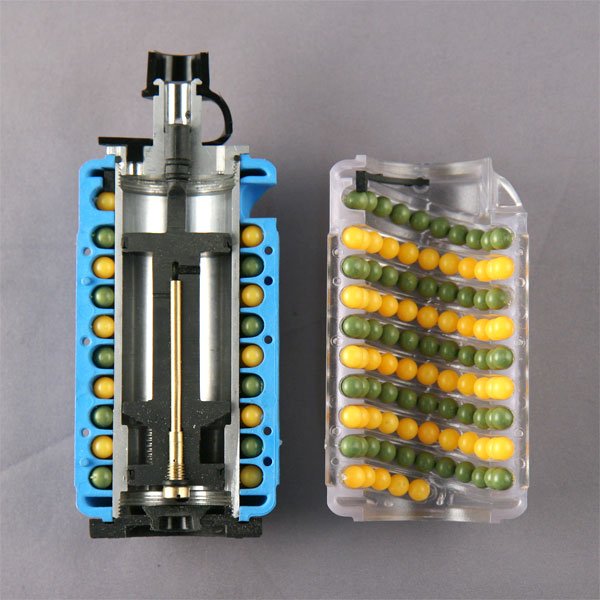
Airsoft Innovations Tornado cutaway
For anyone really interested in the workings of the Tornado, AI have posted a detailed explanation at http://www.airsoft-innovations.com/nadeart4.html.
Weight : 210g
More details from Airsoft Innovations
Austrian AATV's excellent video review of the Tornado (Kindly they did it in English!)
Back to the Homepage